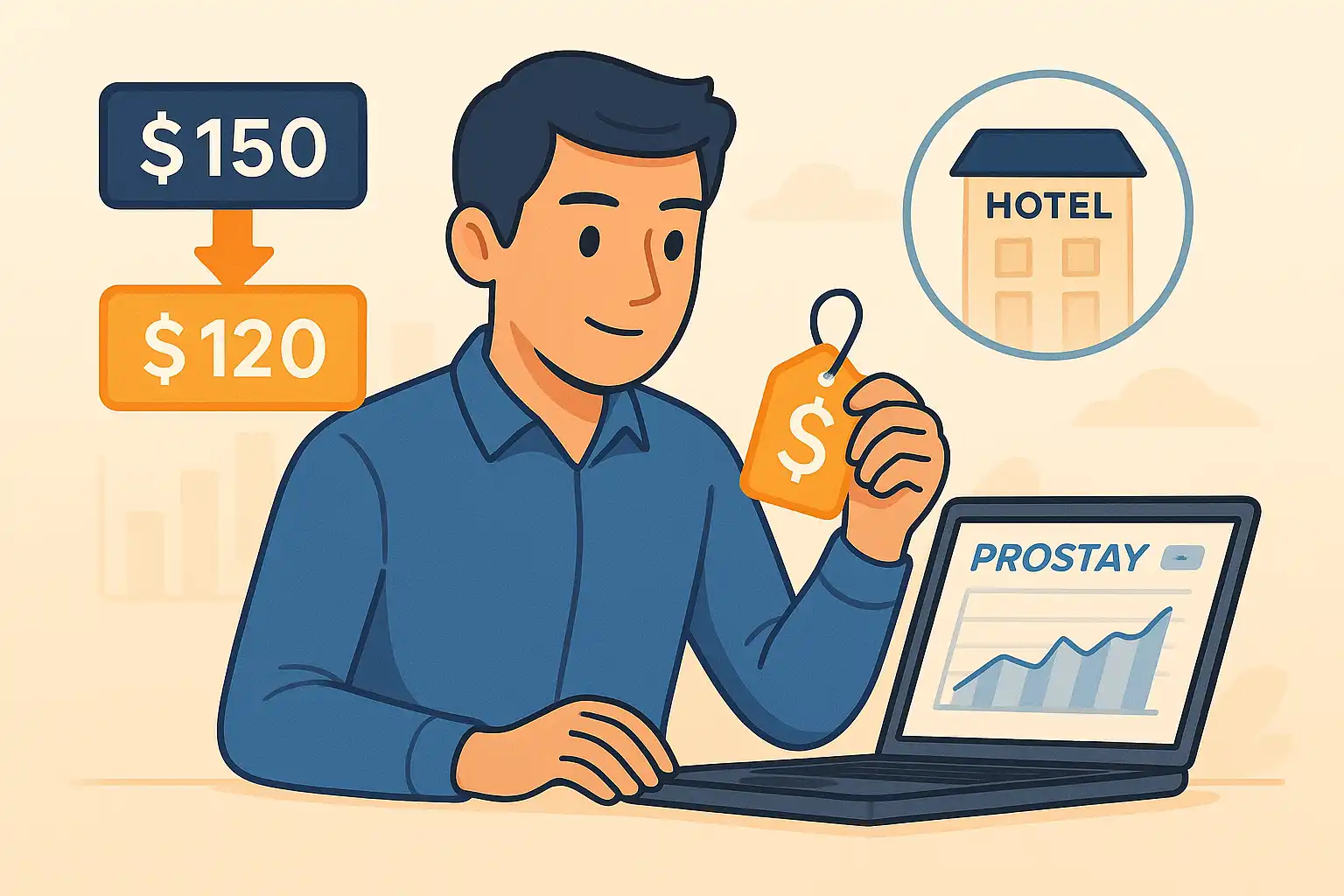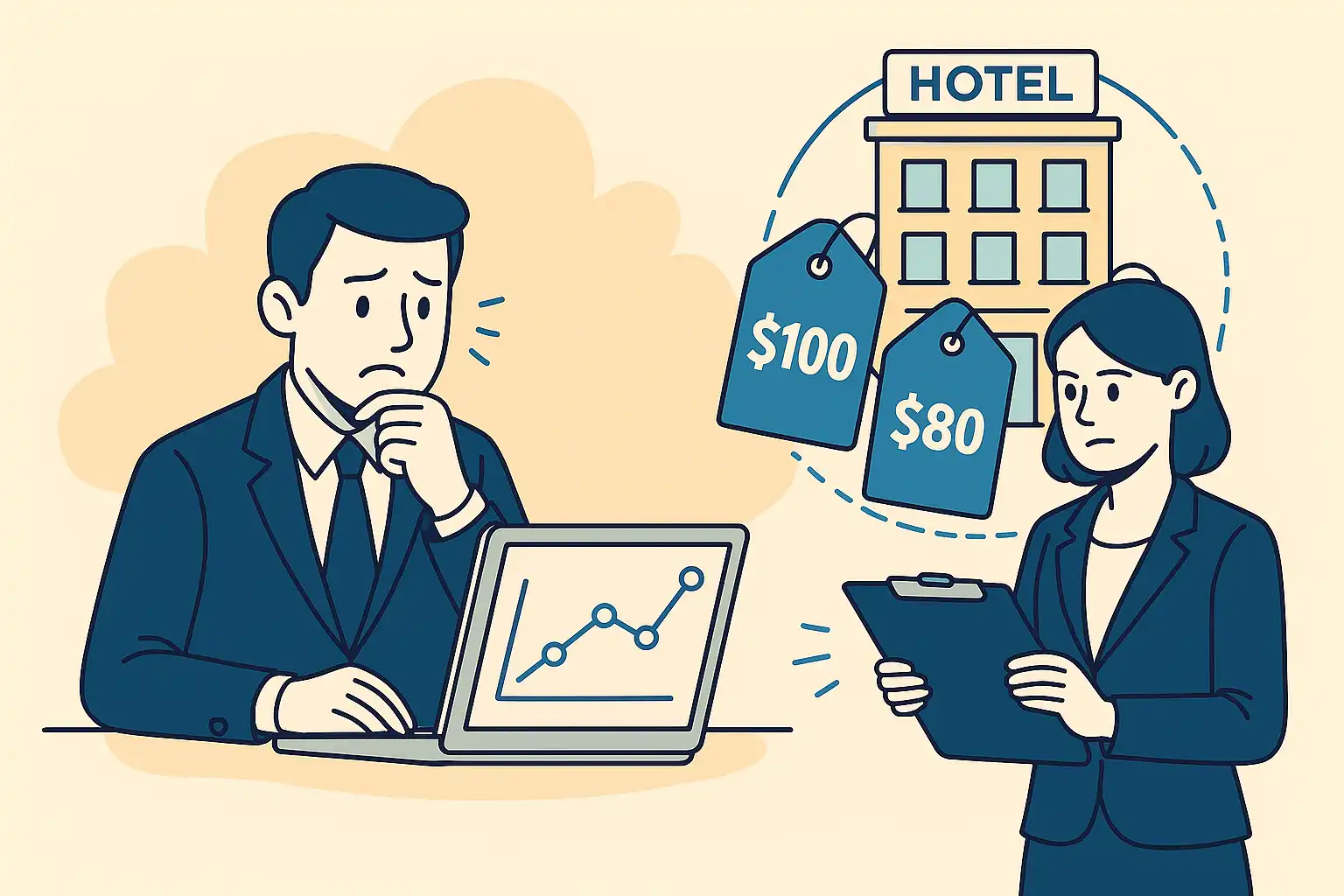Hotel Rate Disparity: Prevent Pricing Inconsistencies
Nov 4, 2025
 Mika Takahashi
Mika TakahashiPopular Categories
Hotel Technology & InnovationHotel Operations OptimizationDigital MarketingIndustry TrendsRevenue ManagementHospitality Industry
Popular Categories
Trending Post

Hotel Walk Letter Template: Professional Guest Communication

Online Travel Agents: What They Are and How They Work

Hotel Security Systems: Modern Protection Solutions

Hotel Advertising: Complete Guide to Boost Bookings and Revenue

25 Hotel Marketing Strategy Ideas for 2025: Complete Guide

AI Reservation Agent: Revolutionizing Hotel Booking and Guest Experience

PMS Communication: Streamlining Property Management Through Effective Guest Messaging
Table of contents
Imagine this: a guest finds your exact same room listed for 20% less on Booking.com, while your hotel website shows the full price. Unfortunately, this isn’t just a rare glitch—it’s a reality for up to 40% of hotels and properties worldwide because of rate disparity. When the same room is priced differently across distribution channels, it sets off a chain reaction of problems that can seriously hurt your direct bookings, damage your brand’s trustworthiness, and ultimately impact your revenue.
Rate disparity has become one of the biggest headaches in modern hospitality revenue management. With properties relying on multiple distribution channels to reach guests, keeping prices consistent has become more challenging than ever. Hotels lose millions every year when online travel agencies undercut their direct price, forcing them to compete against their own inventory at cheaper rates.
In this guide, we’ll break down what rate disparity really means for your property, how it impacts different types of hospitality businesses, and most importantly, how you can stop it from happening. We’ll share proven strategies that successful hotels and vacation rentals use to maintain hotel rate parity and protect their revenue streams.

What is Rate Disparity in Hospitality?
Rate disparity happens when the same room or accommodation is priced differently across various distribution channels at the same time. So, a guest searching for the same room type, dates, and booking conditions might see very different prices depending on whether they’re booking on your own site, an OTA, or another third party channel.
Here’s a simple example: your hotel’s website lists a standard king room for $150 per night, but Booking.com shows it for $135, and Expedia offers it for $142. Even though it’s the exact same room with the same cancellation policy and amenities, guests see three different prices.
This inconsistency is the opposite of hotel rate parity, which means having consistent pricing across all channels. Rate parity is the gold standard in the hotel industry—it ensures that no matter where a guest books, whether on your direct site, an online travel agent, or any authorized platform, they get the same fair deal.
Rate disparity is a major challenge for all kinds of hospitality businesses, from small boutique hotels to large resorts and vacation rentals. As more distribution channels pop up and the digital booking landscape grows, it’s become harder than ever to keep prices aligned.
When pricing isn’t consistent, it can confuse guests, erode trust, and harm your hotel’s reputation. Consistent pricing builds trust, and when that trust is broken, it’s tough to regain.
How Rate Disparity Affects Different Hospitality Properties
The effects of rate disparity differ depending on the size and type of property. Each segment faces its own unique challenges when prices don’t match up, impacting revenue and guest relationships in different ways.
Independent Hotels and Boutique Properties
Independent and boutique hotels often feel the pinch of rate disparity the hardest. They usually don’t have large revenue management teams and often juggle multiple roles, making it tough to monitor all distribution channels closely.
For example, a boutique hotel in Seattle found that OTAs were undercutting their direct price by 12-18%, leading to 60% of bookings coming through third party platforms instead of their own website. This shift meant losing thousands in commission fees and missing out on building direct guest relationships.
Brand reputation is especially fragile for these properties, which rely on personal touches and unique experiences. When guests find cheaper rates elsewhere for the same room, it hurts the hotel’s positioning and can lead to negative reviews that hit smaller businesses harder.
Without the resources of bigger chains, independent hotels often discover rate disparities days or even weeks late, making it harder to fix the problem and protect their revenue.
Hotel Chains and Franchise Properties
For hotel chains and franchises, rate disparity can affect thousands of rooms across multiple locations, multiplying the revenue impact.
Franchise agreements often include strict hotel rate parity clauses, so inconsistencies can lead to penalties or even violations of contracts. One major hotel chain found that inconsistent enforcement of rate parity across its North American properties was costing over $2.3 million a year in lost direct booking revenue.
Loyalty programs also take a hit when guests see different prices across channels. Loyal customers expect a best deal and consistent pricing—when that trust erodes, it can hurt long-term relationships and reduce the value of loyalty investments.
Legal risks come into play too. When hotels can’t honor “Best Rate Guarantee” promises because of unauthorized lower rates on OTAs, they may have to compensate guests, adding to financial losses.
Vacation Rentals and Short-Term Accommodations
Vacation rentals face their own challenges when it comes to rate disparity. Managing consistent pricing across platforms like Airbnb, VRBO, direct booking sites, and property management systems requires coordination that many individual owners don’t have.
Seasonal pricing differences can cause big disparities. A Florida beachfront rental found that different platforms applied conflicting seasonal rates, resulting in up to 25% price differences during peak winter months. This confused guests and lowered booking conversions.
Guests comparison shop heavily in this segment, so even small price differences can drive bookings to competitors. When the same property shows different prices across channels, it damages trust and reduces repeat bookings.
Resort and All-Inclusive Properties
Resorts and all-inclusive hotels have complex pricing structures that bundle accommodation with meals, activities, and amenities, making hotel rate parity even trickier.
Wholesale rates intended for tour operators sometimes leak onto unauthorized platforms, causing rooms to sell for 30% less than direct prices. One Caribbean resort had to take legal action and renegotiate contracts to stop this leakage.
Group booking rates that conflict with individual traveler prices add another layer of complexity, often undercutting individual bookings and creating confusion.
International pricing differences for resorts serving global markets can also cause rate disparities due to currency, promotions, and local market conditions.

What Causes Rate Disparity?
Knowing what causes rate disparity helps you tackle it head-on. Most issues come down to distribution channel practices, technical glitches, and contract management gaps.
OTA and Distribution Channel Practices
OTAs sometimes lower their commission margins to offer cheaper prices, undercutting your direct site rates. This “commission compression” helps them win bookings but creates rate disparity.
Unauthorized reselling by wholesalers and bed banks is another big problem. Wholesale rates meant for specific partners leak onto consumer booking sites at prices well below your direct rates.
Some third-party sites use bait-and-switch tactics, showing low initial prices that jump during checkout, confusing guests and creating apparent disparities.
Flash sales and promotions run by OTAs without syncing with hotels cause temporary but damaging rate differences.
Technical and Operational Issues
Manual rate updates cause delays and inconsistencies. Many hotels still rely on manual processes, which are prone to human error and timing mismatches.
Channel manager failures or connectivity issues can stop rate changes from updating across all platforms simultaneously.
Caching differences—where some sites update prices faster than others—create windows where guests see different prices.
Dynamic pricing algorithms updating at different speeds across channels can also cause disparities, even when base rates are aligned.
Contract and Relationship Management Gaps
Weak contracts with wholesalers allow unauthorized reselling and rate leakage.
Older contracts might lack clear hotel rate parity clauses, making enforcement difficult.
Without regular monitoring, rate disparities can go unnoticed for weeks or months.
Insufficient training for revenue teams on contract enforcement leads to slow or inconsistent responses.
The Financial Impact of Rate Disparity
Rate disparity doesn’t just cause small pricing differences—it can seriously drain your revenue in multiple ways.
Direct Revenue Losses
Guests naturally book where prices are cheapest. Consistent rate disparities can slash direct booking revenue by 15-25%.
Commissions on OTA bookings eat into profits. While direct bookings have low processing fees, OTA commissions can be 15-25%, so shifting bookings to OTAs due to cheaper rates hits your bottom line hard.
Guests booking direct often spend more on extras like dining and activities. One Hawaii resort found direct bookers spent $127 more per stay on ancillary services compared to OTA guests.
Average daily rates drop when hotels have to match lower OTA prices or compensate guests under “Best Rate Guarantee” policies.
Marketing and Customer Acquisition Costs
When OTAs undercut your rates, you end up paying up to 47% more on pay-per-click ads to compete for branded search traffic.
“Best Rate Guarantee” campaigns lose credibility when guests find cheaper prices on third party sites, reducing conversions.
Handling price match requests and complaints adds customer service costs—one mid-size chain spent $850 monthly in staff time just managing rate disparity issues.
SEO efforts suffer when OTAs rank higher with discounted rates, cutting into your organic traffic and marketing ROI.
This vicious cycle reduces your direct bookings while increasing costs, making distribution strategy sustainability tough.
How to Prevent Rate Disparity
Stopping rate disparity takes a mix of technology, contracts, and processes.
Technology and Automation
Use centralized channel managers that sync rates in real-time across all distribution partners.
Deploy rate monitoring tools like OTA Insight, RateGain, or Triptease to catch disparities quickly.
Dynamic pricing software that updates all channels simultaneously helps avoid timing gaps.
Set up automated alerts to notify your team immediately of any pricing inconsistencies.
Contract Management and Partner Relations
Include strict hotel rate parity clauses in all OTA and wholesaler contracts.
Regularly audit partners to ensure compliance.
Negotiate penalties for unauthorized undercutting.
Keep open communication lines with OTA account managers for fast issue resolution.
Internal Process Optimization
Train your revenue team on proper rate distribution and escalation procedures.
Create standardized rate update schedules to minimize timing gaps.
Use dual-approval systems to catch errors before they affect pricing.
Develop clear incident response protocols for quick resolution.

Best Practices for Maintaining Rate Integrity
Keeping rate parity is an ongoing effort that requires vigilance and smart management.
Monitoring and Compliance
Conduct daily audits across your top distribution channels.
Use VPN testing to check for geographic pricing differences.
Perform mystery shopping to verify actual booking rates.
Keep detailed logs of rate disparity incidents and resolutions.
Value-Added Strategies
Offer perks like free parking, Wi-Fi, or breakfast on direct bookings to add value beyond price.
Build loyalty program benefits that encourage direct bookings.
Create exclusive packages and bundles available only on your own site.
Provide flexible cancellation policies for direct bookers.
Crisis Management and Recovery
Set up 24-hour response protocols for major rate disparity issues.
Have guest recovery procedures ready for complaints and price match requests.
Use standardized communication templates for OTA notifications.
Maintain legal counsel contacts for contract enforcement when needed.
The most successful properties treat rate parity as a strategic priority, combining monitoring, value creation, and crisis management to protect revenue and keep guests coming back through direct channels.
